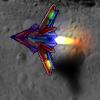Hello,
I am currently developing a prototype of a 2d game where the user can built his own spaceships with tiles.
The player also places the jets which give him thrust to move and steer it.
In order to do that, the velocity and rotationVelocity must be calculated.
Unfortunately I do not know very much about physics. How can I do this?
Known properties of a ship:
-Velocity
-center of gravity
-weight
I hope my goal is not too ambitious ![]() Thanks in advance, Phil.
Thanks in advance, Phil.






